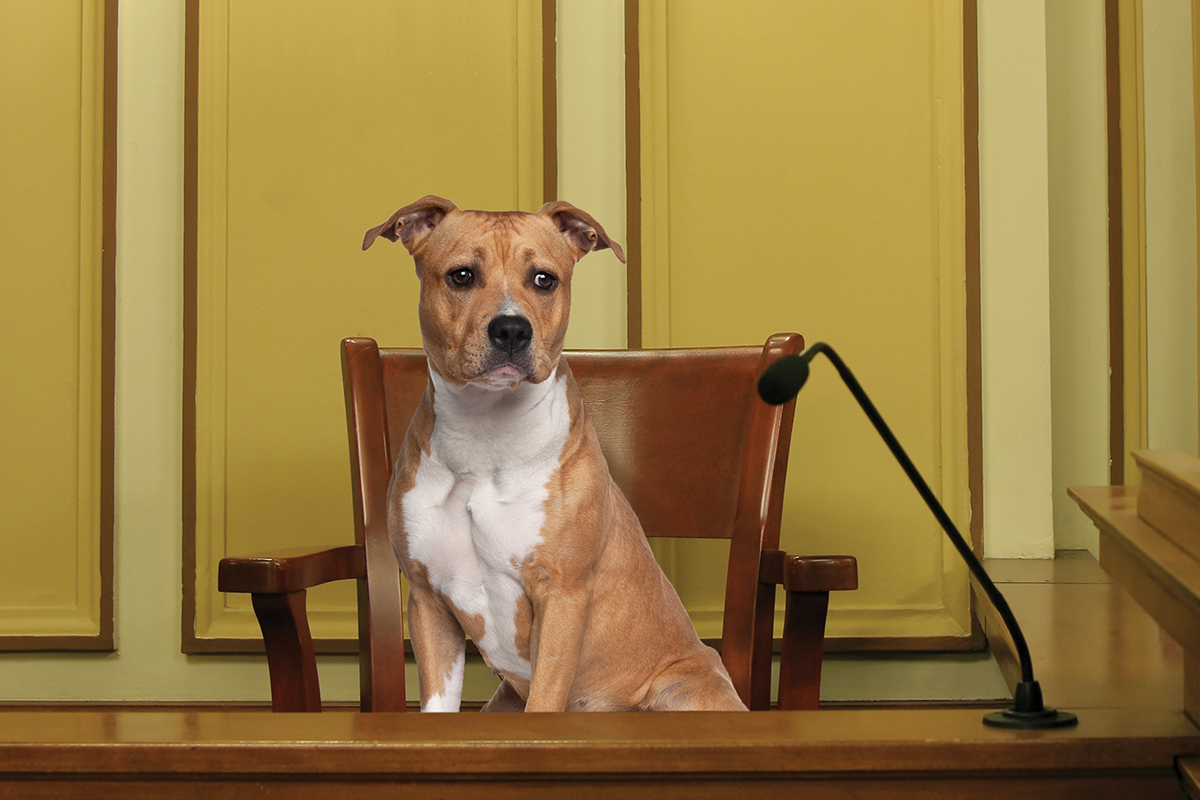Twenty-one lives hinge on the outcome of a case being heard in a small courtroom near Chatham, Ont., packed with spectators on a sunny day early last November. Some of the spectators wear bright yellow T-shirts emblazoned with the slogan “#savethe21.” They had risen early and boarded a bus to make the 300-kilometre trip from north of Toronto to the Chatham-Kent Provincial Offences Court.
The “21” won’t be joining them in court. Even if they were, they couldn’t speak for themselves. The 21 are allegedly former fighting dogs, among a total of 31 seized when police and the Ontario Society for the Prevention of Cruelty to Animals (OSPCA) raided a rural property in the Chatham area, arresting three people and laying hundreds of charges. Two others would eventually be charged as well. Police said they found items relating to dog-fighting and training. The “pit bull-type” dogs seized from the property were turned over to the OSPCA, the organization responsible for animal welfare in the province. Three dogs were euthanized for medical reasons, and the OSPCA sought court approval to put down a further 21, arguing the animals had irreconcilable behaviour issues, and couldn’t be put up for adoption anyway because a provincial law prohibits the breed.
You may unsubscribe from any of our newsletters at any time.
Catching wind of the case, a dog-rescue group and an animal rights organization jumped into the fray, arguing that former fighting dogs can be rehabilitated and offering to shelter and work with the 21 until they’re ready to transition into homes in locations where owning the breed is allowed. In an unlikely alliance with the dogs’ owners, they applied for intervenor status in the OSPCA’s application.
The different groups have different reasons for wanting to intervene, but one theme is common to both: the dogs are innocent victims and do not deserve to die for the alleged sins of their owners. Furthermore, they should be entitled to representation in the courtroom because they cannot speak for themselves.
A generation ago, the 21 would likely have been put down with little or no fanfare. But driven by scientific advances and a heightened ethical awareness of the relationship between humans and animals, attitudes are changing. The case of the 21 is one of a number of recent instances where activists have sought to blur the line between the rights of animals and the rights of humans. Some groups would like to see the line erased completely and have animals legally recognized as persons — non-human persons, but persons nevertheless.
One of those groups is represented in the Chatham-Kent courthouse today. This is the second time this week that Camille Labchuk, a lawyer and executive director of Toronto-based Animal Justice, has been in an Ontario courtroom; earlier she live-tweeted from the trial of a woman who was charged with criminal mischief for giving water to slaughterhouse-bound pigs on a hot day early last summer. Today, Labchuk sits as close as possible to the front of the courtroom, beside the lawyer who is representing the organization, Marc McLaren-Caux.
The other party in court today seeking intervenor status is Dog Tales, a privately run dog rescue and horse sanctuary north of Toronto. Dog Tales’ lawyer is John Nunziata, a former federal member of Parliament. He appeals to “common sense” as he tells the judge that the refuge is equipped to oversee the dogs’ recovery and rehabilitation, and to evaluate their suitability for adoption. Dog Tales says the OSPCA is persecuting the 21 because they belong to a breed demonized by popular misconception and legislation that targets them: spurred to action by a number of pit bull attacks on humans, Ontario outlawed the ownership, breeding and importing of pit bulls in 2005. The City of Montreal passed a similar ban last fall.
Animals already have some legal protection in the form of animal cruelty laws. But animal rights activists argue that the laws are rarely enforced and don’t address the real issue that prevents animals from getting a fair shake: they’re viewed as property.
But they’re “a weird kind of property,” says University of Alberta law professor and animal advocate Peter Sankoff. You can own a table and you can own a cow, but it’s intuitively clear to most people that a cow isn’t like a table. Sankoff believes the current law around animals doesn’t reflect the distinction.
“We’ve made huge progress on women’s issues, racial issues, disability issues, equity issues,” says Labchuk. “The one vulnerable population that we’ve almost completely ignored until recently is animals.”

The Criminal Code of Canada outlaws mistreatment of animals, but critics say that it hasn’t been substantially updated since the 1950s and is full of loopholes. A recent private member’s bill — titled the Modernizing Animal Protections Act and introduced by Toronto Liberal MP Nathaniel Erskine-Smith — would have moved animals out of the property section of the Criminal Code and into a new section titled “Offences against animals,” housed in the part of the code dealing with public morals. Animals would have remained legal property, but the new law would acknowledge, in Erskine-Smith’s words, “that animal cruelty is a crime because it’s wrong, in and of itself, to harm animals unnecessarily.” Despite last-minute concessions from Erskine-Smith and support from hockey commentator Don Cherry, the bill was roundly defeated, with 117 members of Erskine-Smith’s own party casting votes against it and opponents claiming it endangered “legitimate animal use” and had the potential to criminalize sport fishing and hunting.
Animal Justice threw its support behind Erskine-Smith’s bill. Undeterred by its demise, Labchuk and her organization are agitating on dozens of other fronts, ranging from circus advertising, to pet breeders, to defending activists who secretly film or photograph examples of animal suffering. Animal Justice is the only organization of its type in Canada, but Sankoff says growing numbers of law students are showing an interest in the kind of issues that he and Animal Justice have tackled, often together.
At the University of Toronto, associate law professor Angela Fernandez helps to lead the Animals in the Humanities and the Law working group. She says that the current law governing animals has roots in the Judeo-Christian tradition, where God is at the top of the hierarchy and animals are below humans, existing to sustain them. “I think the practice [of animal use] sort of pre-exists there being a law about it,” she says. A tradition this old does not change overnight. In Fernandez’s view, the negative response to Erskine-Smith’s private member’s bill shows how deeply entrenched the hierarchical outlook really is.
While animal rights lawyers toil on individual cases to set precedents and gain legitimacy for their cause, the end game for some — including Animal Justice — is legal personhood for animals. That would mean that animals would have legal standing and could be the plaintiffs in actions pertaining to their own treatment — like Naruto the crested macaque, who was at the centre of the “monkey selfie” case a year ago. In 2011, a British wildlife photographer working in Indonesia set up a camera on a tripod and left it unattended, its remote shutter easily accessible. A crested black macaque monkey found the shutter and took some adorable self-portraits that were later included in a book authored by the photographer. The photos became the focus of a court case in which the animal rights organization People for the Ethical Treatment of Animals (PETA) argued that the macaque was the legal creator of the photographs, that the photographer had infringed on the animal’s copyright and that Naruto was entitled to the money the photographer had earned from the photographs.
A judge in northern California ruled against PETA and Naruto, but last summer PETA filed an appeal. In a related brief filed with the court, University of Notre Dame anthropologist Agustín Fuentes, a leading authority on human and primate interaction, took up Naruto’s cause. “Animals can be the authors of valuable works of art, and there is a market for art created by animals,” Fuentes wrote. “The photographs at issue in this case are works of art authored by Naruto . . . and the best available research strongly supports the contention that Naruto easily satisfies the basic requirements for authorship.”
The press has mostly made light of the case (“The ‘monkey selfie’ battle heads back to court — and gets even more bananas,” declared the Washington Post) but the animal rights movement sees it as a step further along the way to legal personhood status for animals. Gabriel Walters, PETA’s counsel and manager of legislative affairs, believes history is on the animals’ side. Viewing animals as property without any rights is the norm today. But slavery was a norm once too. “We need to examine those norms,” says Walters.
Asked if his goal is animal personhood, Sankoff pauses. “I’m not convinced that making the changes is even possible under the current paradigm,” he says. It’s a question of tactics and resources: he can’t even think that far into the future when animals are suffering now. He sees his main responsibility as pointing out where the current laws fail. Still, he spoke out in support of the Modernizing Animal Protections Act on a number of occasions and wrote a scathing op-ed article for Policy Options after it failed.
In Canada, Labchuk and Sankoff were granted leave to argue the interests of a dog in a horrific child abuse case that made its way to the Supreme Court in 2015. The high court’s eventual ruling was not what the two lawyers had hoped for, but they still consider it a partial success. The fact that they were able to stand up at all in the Supreme Court to represent a dog’s interests was a victory. “We were actually able to convince them that, yes, it is worthwhile to listen to somebody who wants to speak about animals. And I don’t think five or 10 years ago we would have gotten in,” Sankoff says.
Multiple forces are driving change. Accumulating scientific evidence points convincingly to the fact that animals, like humans, are sentient: they are self-aware and have feelings. Documentary films focusing on the plight of animals have been massively successful, reaching millions of viewers. And thanks to social media, the animal rights agenda knows no physical boundaries. “A few years ago, you could not speak with a straight face — or rather, you could not speak with someone and receive a straight-faced response — about banning marine animals from aquatic theme parks, and now it’s starting to happen,” says George Dvorsky, a Canadian bioethicist and science writer. He heads the Rights of Non-Human Persons Program at the Institute for Ethics and Emerging Technologies, a non-profit group based in Connecticut. Dvorsky’s program is “committed to the idea that some non-human animals meet the criteria for personhood” — that they are individuals with their own sophisticated social orders and emotional bonds to one another and the world around them — and should be extended rights and protections. “These ideas do trickle down and become part of the larger vernacular,” he says, but it takes a long time.
Animal Justice features an “Animal Charter of Rights and Freedoms” prominently on its website. Its basic tenets: animals have the right to have their interests represented in court, and they are persons under the law. Labchuk admits it’s more of a talking point than a manifesto. But Canada would not be alone if it were ever to move toward granting animals more rights. In 2015, New Zealand amended its animal welfare legislation to recognize that animals are sentient, requiring animal owners to “attend properly to the welfare of those animals,” and banning the use of animals for the testing of cosmetics. “To say that animals are sentient is to state explicitly that they can experience both positive and negative emotions, including pain and distress,” Dr. Virginia Williams, a veterinarian and then chair of New Zealand’s National Animal Ethics Advisory Committee, told the international animal advocacy group Animal Equality. In Germany, animals have enjoyed constitutional protections since 2002. In 2007, the Balearic Islands — an autonomous region of Spain — passed legislation that effectively granted legal personhood to great apes. Declaring dolphins to be non-human persons, India’s Ministry of Environment and Forests banned the confinement of live dolphins for commercial exhibition in 2013.
A judge in New York State sent shockwaves through the legal community in 2015 when she temporarily granted a writ of habeas corpus to a pair of chimpanzees that animal rights activists were trying get released from a university laboratory. By resorting to a legal concept designed to secure justice for humans, the judge appeared to be saying that the chimps were persons too. She later backed off, citing earlier precedents, but remained surprisingly sympathetic to some of the activists’ legal arguments, including their contention that the idea of legal personhood continues to evolve. The animal rights movement hailed the episode as another step toward an inevitable rewriting of the law.
Recent decisions in Canada have activists convinced the law here will someday change too. “Animals might not yet have rights in the conventional sense . . . but the very least that can be said is that their status is evolving,” wrote an Alberta judge in a decision where he ruled that a woman’s two cats were “not simply chattels.” In another case involving an elephant in an Edmonton zoo, Chief Justice Catherine Fraser seemed to acknowledge that attitudes were changing when she wrote that activists intervening on behalf of the elephant were “entitled to their day in court.”
Logically, what that means is that the animal was entitled to its day in court, which is precisely what Animal Justice and Dog Tales are seeking with their applications to intervene in the matter of the 21 pit bulls in Chatham. The case has dragged on for more than a year. The dogs remain in the custody of the OSPCA, kennelled in an undisclosed location. While the OSPCA insists that they are receiving the best care possible, lawyer Nunziata complained to the local media that the time spent in court fighting to save the dogs could have been better spent rehabilitating them.
A decision on the intervenor applications was expected in late December, but the ultimate fate of the pit bulls remained unclear. In the meantime, the OSPCA reported that more than a dozen puppies had been born from among the 31 dogs seized in the original raid. Their status before the law, and the status of all dogs, could well rest on what happens to the 21 now sitting in limbo.
This story first appeared in the January 2017 issue of The Observer with the title “From kennel to courtroom.”













